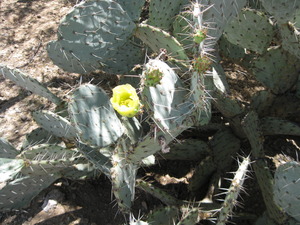Cactus is often associated hot, dry desert areas. It is true that many cactus love dry weather, but they also grow at higher elevations where temperatures dip well below freezing. If you are looking to add cactus to your desert landscaping, pick species tolerant of winter low temperatures where you live if you don’t want to risk losing them. Caring for cactus in the winter is much easier with the right plant.
Cold Hardy Prickly Pear Cactus
Prickly pear cactus are one of the most diverse species of cactus, and grow anywhere from sea level to 10,000 feet in elevation. Obviously, It is not unusual to see them covered with snow. The hardiest species include:
- Beavertail Prickly Pear has lovely magenta spring flowers.
- Plains Prickly Pear has yellow or pink flowers. The fruits are very dry as opposed to other species of prickly pear.
- Brown-spined Prickly Pear has yellow flowers and plump, juicy fruits.
Cold Hardy Barrel Cactus
- The Arizona barrel is found at elevations up to 5600 feet. At first the Arizona barrel is round, it eventually elongates. It is sometimes mistaken for a sahuaro. The Arizona barrel has orange, red or yellow flowers, and grows to a height of about 8 feet.
- The California barrel is another hardy barrel cactus. It grows up to 10 feet tall, thriving anywhere from 200 feet to 5,000 feet in elevation. The spines are very dense; so much so you can’t see the flesh between them. The flowers are pale red to yellow.
- The Texas barrel is a small cactus only reaching 1 foot tall. The thorns are interesting; twisting every which-way creating a tangled look. Don’t be alarmed if the green summer color turns purple in the winter. This is normal. The Texas barrel is hardy from 30 to 5000 feet in elevation.
Watering your Cactus in the Winter; Is it Necessary?
Cactus do not need supplemental water during the winter as long as winter rains are normal. However, if winter rains fail to appear, it is a good idea to give them a deep soaking, especially if the dry winter follows a dry summer. Do not water at the base of the plants. Water absorbing roots are all the way around the plant, and extend to at least 2 to 3 times the height. For established cactus, water to a depth of 3 feet. Once a month winter watering is sufficient until it rains several days in a row.
Protecting Tender Cactus from Frost
Frost protection is not necessary if you selected hardy cactus for your landscaping. If you have exotic, frost tender species, you will need to protect from frost.
Columnar cactus, including those in the Cereus family, are especially susceptible to frost damage. Cover these plants with cloth or frost protection blankets. Do not wrap around the plant, as this does not work. You need to make a tent over the top and secure to the ground. This is because you are trying to capture soil warmth as it rises, not keep frost from landing on the skin. Always remove covers during the day, especially if the sun shines, so you can capture more warmth if another freeze is predicted.
References: Irish, Mary F., Gardening in the Desert, The University of Arizona Press, 2000.
Fischer, Pierre C., 70 Common Cacti of the Southwest, Southwest Parks and Monuments Association, 1989
Stanley Schuler, editor, Cacti and Succulents, Simon and Schuster, Inc. 1985
Hot and Dry Climate Shrub Choices for Screening
Screening Options for Desert Landscaping
Adding Shade to Desert Landscaping: Beyond Trees



